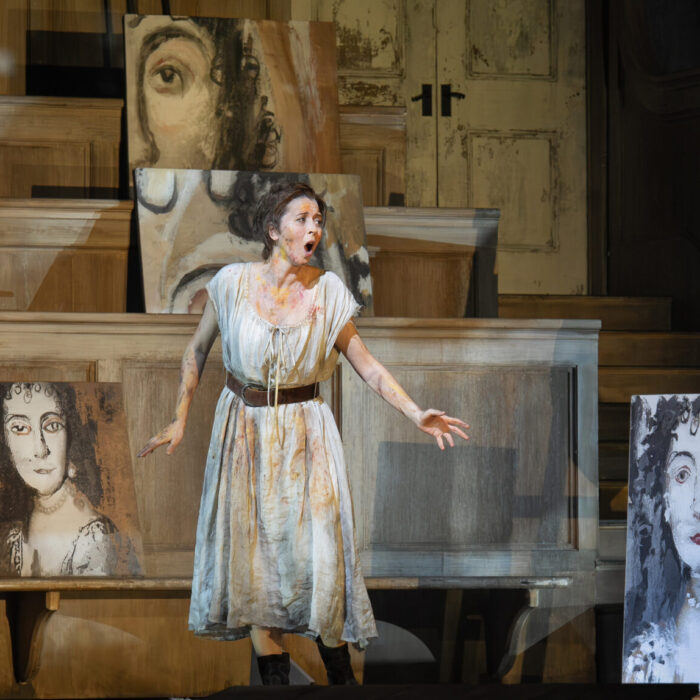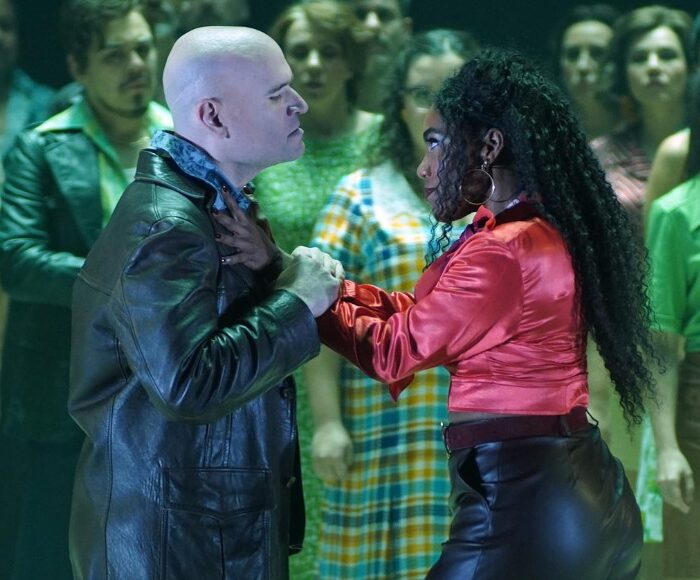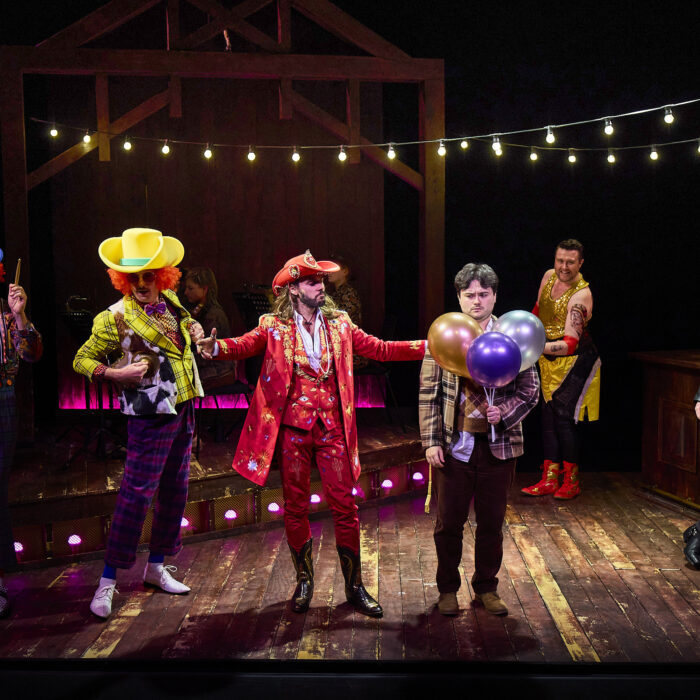
Metropolitan Opera 2017-18 Review-Lucia di Lammermoor: Jessica Pratt Is A Revelation As Donizetti’s Tragic Heroine
By Francisco Salazar“Lucia di Lammermoor” is a role known for its high-flying coloratura, its expansive and dramatic scenes and, of course, the mad scene. In order for a Lucia to work, there must be a soprano who can handle all the challenges and a supporting cast that can work around her. There must be a soprano who cannot only conquer the virtuoso singing, but someone who can express every emotion in the character and who, with vocal beauty, can make audiences feel sympathetic.
Earlier in the season, Olga Peretyatko conquered the role with incredible agility and vocal pyrotechnics alongside a solid cast. Now at the end of the first run of the opera, it was up to a new soprano to take on the role, Jessica Pratt. And stepping in with just two performances, Pratt created a memorable if sometimes uneven evening.
Vocal Fireworks
Pratt has sung over 20 productions of Lucia, so it was no surprise that she could easily step into the role and make it her own. On the final evening of her run, she got off to an uneven start however. She walked on with a girlish look and when she began to sing her “Regnava nel Silenzio” her timbre gleamed with floating top notes and beautiful legato lines. Yet there was a coolness to the singing that felt disconnected from the Mary Zimmerman staging. Her interactions with the ghost seemed more of a routine than a girl haunted by ghosts and her use of the immense stage was limited to her standing stage right, making the whole scenery extremely barren. But in the cabaletta “Quando Rapito in Estasi” Pratt came into her own demonstrating vocal agility and ravishing fiorturas. Her interactions with Deborah Nansteel’s Alisa were subtle and girlish and it gave us a sense of an innocent and charming Lucia. She capped off her cavatina with a gorgeous D that at one point seemed to come after awkward orchestral cuts.
It seemed like the evening was getting going but her duet with Edgardo was troublesome. In this performance, Vittorio Grigolo returned with the same impassioned fire as opening night and somehow overpowered the soprano throughout the entire duet. One could barely hear her alongside Grigolo which was surprising because Pratt has an immense voice that easily fills the large Met hall. Throughout “Verranno a Te” she seemed tentative, beginning the long phrases with noticeable intonation issues and a lack of volume. It was an interesting display and Grigolo didn’t hold back his volume nor his desperate Edgardo. What should have been a climactic end of first Act, was a display of two singers in different operas.
Luckily once the second act began, audiences were in for Jessica Pratt at her best, where she would remain for the rest of the opera. What seemed like a tentative and cool singer in the first Act, quickly transformed into a fierce and chilling singing actress. Her duet with Enrico, which is the defining and most dramatic moment in the opera, showcased Pratt singing with impassioned lines and a ringing tone. Her Lucia was far from a strong woman and when she confronted Massimo Cavalleti’s Enrico, she was quickly thrown to the floor. Each subtle movement showcased her pleas but also her weakening character. At one moment she ripped the false letter given to her by Edgardo almost as if she wanted her circumstance to not be true. In the “Sei tradirmi,” Pratt slowed down the tempo a bit to give a sense of anguish and pain.
Her Lucia continued to become unhinged in the subsequent duet with Raimondo and what was most striking was her ascension to the High F to cap the duet. It could have been a display of pyrotechnics but Pratt really gave it an intensity that showed this Lucia was turning mad.
And that turn came in the next scene. As Lucia walked into the wedding, Pratt was hesitant with each movement, driving her away from the scene. But Cavalletti continuously used his force on her, pulling her to sign the wedding contract. When Edgardo bursts onto the scene, Pratt could not take her eyes away from him almost as if she still had hope of being saved. Her singing in the sextet came with great strength as her volume powered through the entire Met auditorium and only grew stronger.
But in the subsequent moments when Edgardo discovers her wedding nuptials, Pratt’s Lucia grew weaker. As Grigolo threw her to the ground and then threw his ring at her, Pratt continuously searched for the ring. During the scene, she searched for her Edgardo only to be blocked by Cavalletti or violently attacked by Grigolo. It only added to the weakening state of Lucia and as the scene continued on, Pratt’s eyes took on a look of confusion. The final note was an effective, desperate cry.
The turn from Act two to Act three was flawless. After having experienced such a traumatic scene, it was a no-brainer this Lucia would go mad. But Pratt’s madness was not one of a deranged, unpredictable woman. She’s was not violent nor dangerous. Instead, this Lucia was frail and haunted. Once she walked onstage, she followed the sound of the glass harmonica, each movement guided by the eerie sound. Her opening “Il Dolce suono” was sung with a pianissimo and upon that she built the phrases with delicacy never letting out her entire volume. That was left for “Il fantasmo,” which she burst out with a forte sound, heightening the torment and pain Pratt’s Lucia was feeling.
Whereas this production has showcased very sexualized interpretations during the second half, “Ardon gli incensi,” Pratt maintained a dream-like state, looking out into the distance as she sat downstage on the prompter box. In many ways, there was a girlish quality to this take that reminded audiences of the youth taken away from Lucia. Instead of interacting with her chorus members, Pratt used the veil as a reminder of what she had lost.
In the famous cadenza, Pratt displayed vocal fireworks, singing with such refinement but never losing sight of the emotion. Each time the glass harmonica played a line, Pratt followed with exact precision. It all melded with such perfection and the sensation was otherworldly. And as she climaxed the scene, instead of finishing with a forte E Flat, Pratt kept the note mezzo forte.
In her subsequent “Spargi d’amaro,’ the soprano’s Lucia became more agitated. While still keeping the frailness in her movements, Pratt’s vocal fiorturas became unhinged, singing numerous roulades and even going up to an E Flat. And the vocal fireworks would not end there as Pratt ended the mad scene with a final and powerful E Flat until the orchestra finished. And it surely caused an impact that left audiences wanting more. It was the perfect way to end what was already a showstopping evening. One hopes that Pratt returns for more Bel Canto because she showcases the best of both worlds – great acting, and impeccable coloratura.
A Solid Supporting Cast
Vittorio Grigolo continues to show the same unhinged singing and passion. It suits the character of Edgardo, who is desperate and romantic. If the singing sometimes lacks the refinement one would expect from bel canto, it definitely suits the role and Grigolo’s fiery character. Bel Canto is about beautiful lines and while sometimes Grigolo’s singing seemed better suited for Verismo, his phrases gave Edgardo another dimension. As with opening night, the sextet was Grigolo’s big moment and he stopped the show with antics and unpredictability. The violence necessary to cause Lucia’s madness was definitely present and here Grigolo was not scared to throw Pratt’s Lucia to the ground or knock chairs around the stage. This was a deranged Edgardo that was lead by passion and not his head.
As Enrico, Cavalletti improved immensely from opening night. His voice packed a bigger punch and his singing more precise. One could feel the strength of his high notes and the power of his booming baritones. Like his opening night performance, Cavalletti continued to showcase that over domineering character but one felt sympathetic moments especially in the duet with Lucia where his constant looks at her, showed his remorse. But this Enrico’s pride always won over.
As Raimondo, Vitalij Kowaljow continued to show a solid bass sound, singing with elegance and precision, while Mario Chang continued to show promise as a tenor to look out for in the future.
The Downside
In the pit, Roberto Abbado’s conducting was filled with sloppy transitions that were not heard when this production opened. It was a reminder of how chopped up this current revival is and how these constant alterations to Donizetti’s music affect the flow and dramatic intentions of the music.
One has to commend Emmanuel Ceysson for his exquisite Harp solo in Act one and Frederich Heinrich Kern for his haunting playing at the Glass Harmonica. The mad scene does not work without an effective partner and Kern was up to the task.
Before I end my review, it is important to notice something in Mary Zimmerman’s production that has not been discussed. Many times, opera companies are looking to cut run times by eliminating intermissions or cutting music. As stated, this production cuts at least 20 minutes of music of a two and a half opera. One would expect these cuts would make the evening shorter and compact. But the exact opposite happens with Zimmerman’s production. There is a 45-minute intermission between Act two and three and the wait is eternal. While the staircase in Act three is an incredible coup d’teatre and visually striking image, it doesn’t merit the wait, especially when the transition into the final scene with Edgardo sees the chorus walking out in such a nonchalant manner. The theatricality of one scene becomes the detriment of another. What should be a quick and dramatic evening becomes an long waiting game. How a two-hour chopped-up opera becomes a three and half hour evening is something I will never understand (the show started at 8 p.m. and ended around 11:30).
But let’s end on a positive note. Jessica Pratt is the real deal and a soprano who deserves more than two performances at the Met. Why she is covering is beyond reason. One hopes that after these two spectacular performances, the Met will give her a full run of performances so audiences and critics can experience one of the opera world’s greatest coloratura singers.


